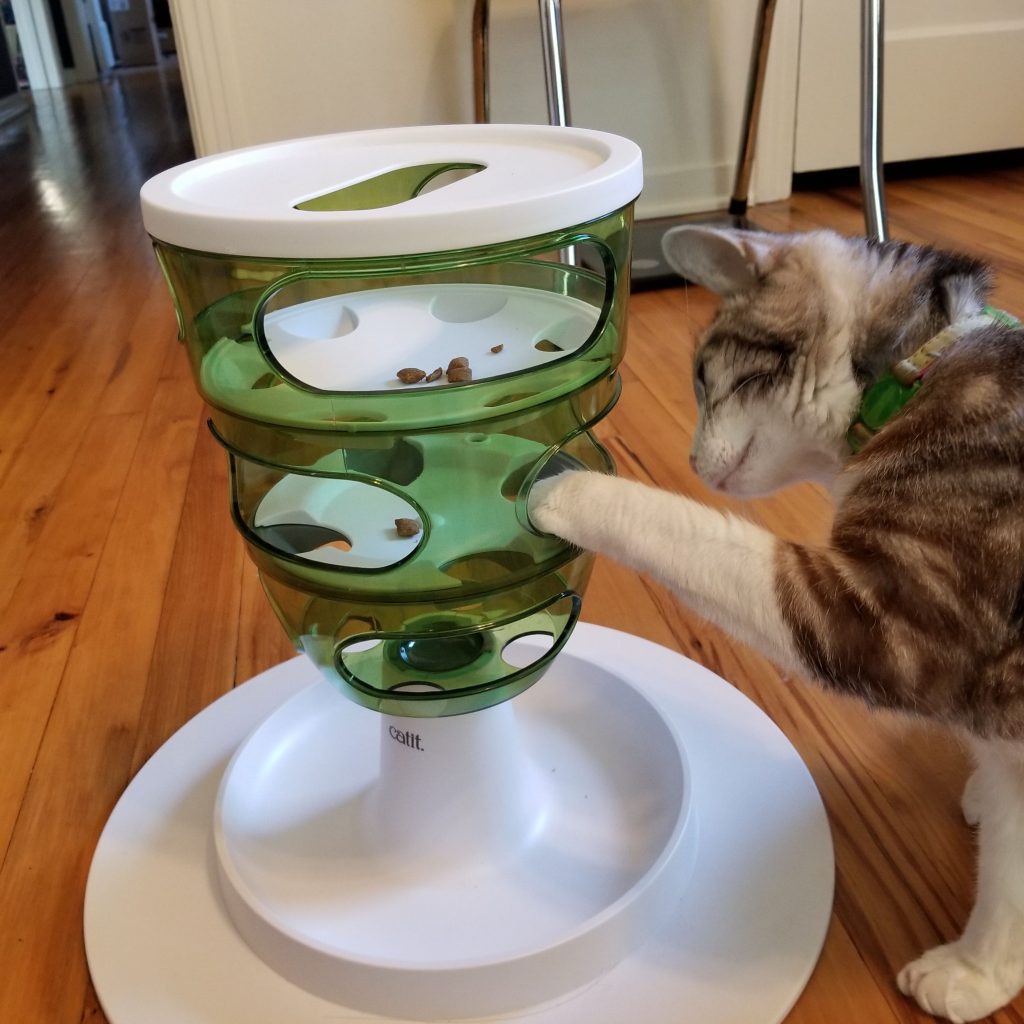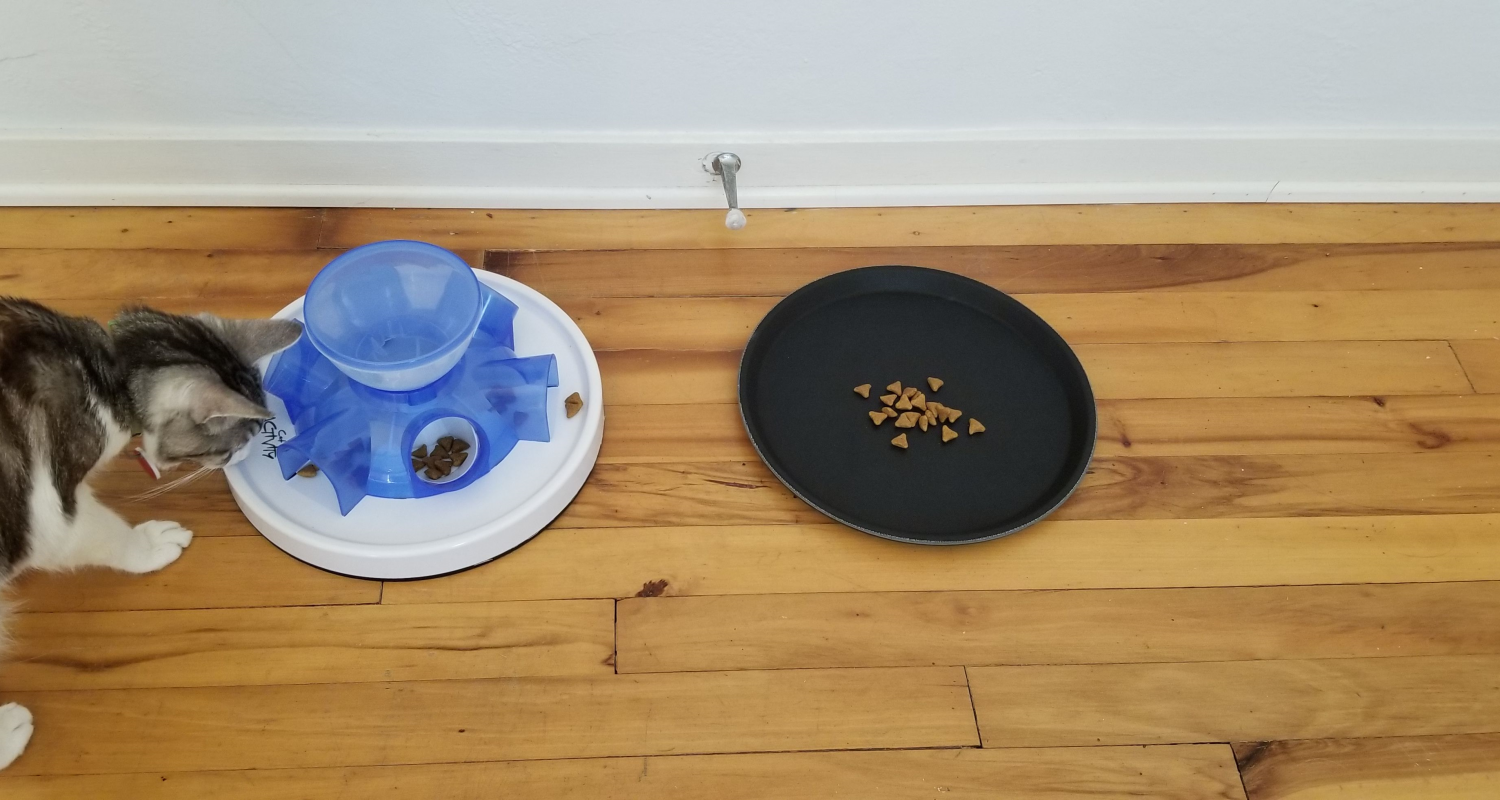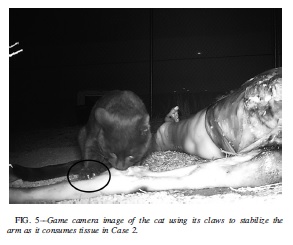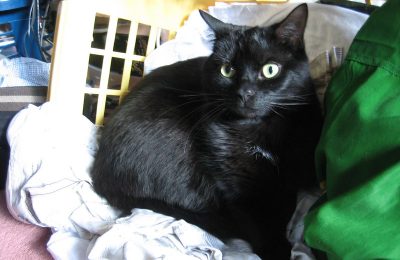What is contrafreeloading?
In the 1960s scientists discovered that laboratory rats liked to work for food. Rather than eat food from a bowl, rats chose to press a lever that would release of food pellets, even when they had to press the lever several times before food was available.
They named this behavior “contrafreeloading” — basically the opposite of freeloading. And over the years, and multiple tests of multiple species, it was determined that captive animals consistently preferred to work for food even when food was freely available. Pigeons, chimpanzees, pigs, bears, chickens, wolves, giraffes, fish, rats, gerbils, and humans…all do it.
Previous research on cats & contrafreeloading
So when I read the 1971 paper “Feline indolence: Cats prefer free to response-produced food” which reported a study that six laboratory cats were freeloaders, eating all free food before being willing to press a lever for food, I was surprised. Cats naturally must “work for food” through hunting, and why would cats be the ONLY tested species that does NOT contrafreeload?
Well, it was just six cats, and they were in a laboratory and kept underweight, so perhaps it was just a fluke? As someone who encourages cat owners/guardians to get their cats working for food via food puzzles, this result has plagued me for some time. And this is how new scientific studies are born. When given a choice between a food puzzle and freely available food, what would housecats do?
What we did
Before the pandemic kicked in, one of my undergrad mentees, Brandon, and I were able to get 20 kitties signed up to test contrafreeloading in the home environment. All cats were the only cat in the home, were indoors-only, healthy, between 1-10 years old, and were spayed/neutered. Each cat was first acclimated to eating from a food puzzle, the Trixie Tunnel Feeder, and a tray that was the same size and shape. Three cats were dropped from the study at this point because they refused to try the puzzle.
For the remaining 17 cats, they were given 10 trials over the course of 3-4 days, where for 30 minutes they had the choice to eat their daily rations from the food puzzle or from the tray. The same amount of food was placed in each, and the side each was placed on (right or left) was alternated randomly (5 on each side) to control for any side bias. Owners video-recorded each session. Because we were interested in whether more active cats would be more likely to work for their food, all cats also wore an activity tracker.
Results
We were interested in how much food the cats ate from each source, which source they would spend more time at, and which they would visit first. Overwhelmingly, the cats ate more food from the tray, they spent more time at the tray, and they visited the tray before the puzzle more often than not. A few cats ate almost NO food from the puzzle. No cats ate MORE food from the puzzle than the tray, and the cats who showed the tendency to contrafreeload (meaning they ate all or most of the food offered in the puzzle) were those that ate ALL food available to them — they were just food frenzied!!
We also found no relationship between activity and how much food was eaten from the puzzle. Another study (which I blogged about a few years ago) found that eating from a food puzzle did not lead to measurable increases in activity in cats, so this finding was not surprising, although still a little disappointing.
So are cats indolent (lazy)? Well, I wouldn’t go that far, but to date we do not have strong evidence that cats prefer to use a food puzzle compared to eating food from an open tray. Does this mean we should not offer cats food from puzzles? I would equate this to the fact that I prefer sitting my ass on the couch surfing the internet over running…but I benefit from the run, and would not say I should not exercise just because it is not my FAVORITE thing to do.
I believe we can still offer cats food from puzzles, but we should do so thoughtfully. Food puzzles are commonly used to provide enrichment for captive animals, to stimulate species-specific behaviors and reduce problematic behaviors such as stereotypies (e.g., repetitive or self-injurious behaviors). Food puzzles can be a very effective enrichment tool for our cats, and I recommend them to my cat consulting clients ALL THE TIME (to mostly positive results). And yes, I use them with my own cats!

But the benefits may be dependent on the cat. Highly food-motivated cats should absolutely be introduced to working for food. The introduction should be slow, and offered as a choice at first. For other cats, food puzzles may need to be used as occasional enrichment, or with novel food or treats, or introduced more gradually. Over time, cats do get more efficient at using food puzzles, and it could be that the two-to-three-week period that each cat was in our study was not long enough to reach that point.
Would I have loved if we found overwhelming evidence that cats prefer food puzzles over freely available food? Sure. But we do science to discover what happens and why, not to prove our pre-existing opinions. There are certainly other tests that could be done that might enhance our understanding of why most cats don’t contrafreeload, and what might increase the chance that they do.
You can read the research paper, “Domestic cats (Felis catus) prefer freely available food over food that requires effort,” it’s OPEN ACCESS!!
I’ve also previously published two papers on this topic:
Dantas, L. M., Delgado, M. M., Johnson, I., & Buffington, C. T. (2016). Food puzzles for cats: feeding for physical and emotional wellbeing. Journal of feline medicine and surgery, 18(9), 723-732.
Delgado, M., Bain, M. J., & Buffington, C. T. (2020). A survey of feeding practices and use of food puzzles in owners of domestic cats. Journal of feline medicine and surgery, 22(2), 193-198.
And if you want to learn more about using food puzzles with cats, you can visit the website I co-manage with my friend and colleague Ingrid Johnson: foodpuzzlesforcats.com!




so interesting! While cats “work for food” through hunting, I’ve also seen studies finding that feline hunting can be independent of hunger (e.g. a well-fed domestic cat will still hunt birds/bugs/etc).
I’ve seen studies that indicating that cats will eat already-dead animals (“tray food”) (eg: a leopard returning to a carcass)-would one surmise that the cat would continue to do so (and not hunt again) until necessary?
Could it be that hunting/working for food fulfills more than just hunger and fulfills perhaps a sense of play?
Could it be a prior-conditioning bias to the food bowl (they are all adult cats who were likely fed in dishes most of their lives)?
I wonder if the food in the puzzle were more attractive than the food in the bowl if that then would make it worth the effort to “hunt” and it’s a conservation of energy proportionate to reward?
😉 or maybe they’re . . .just lazy!